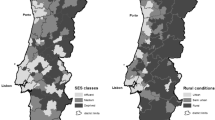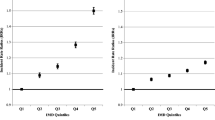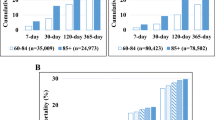Abstract
Summary
The association between socioeconomic status (SES) and hip fracture (HF) incidence was analyzed in France in 2008. In men and women, a decrease in HF incidence was observed as the social deprivation index increased. This result may be partly due to the protective effect of increasing body weight against HF.
Introduction
Regional variations in hip fracture (HF) incidence exist worldwide. Reasons for these variations remain unknown. As regional variations have also been observed for socioeconomic status, we analyzed the association between socioeconomic deprivation (SED) and HF incidence in France in 2008.
Methods
From the French Hospital National Database, we selected all HF encoded as primary diagnosis in persons aged 30 years and over. The recently published French version of the European Deprivation Index (EDI) was used for SED analysis, and an EDI score was measured for the year 2007 in each French local municipality. The EDI score was categorized in quintiles. Poisson regression was performed to examine the association between HF incidence and EDI adjusted for age and sex. The population attributable fraction (PAF) was measured to calculate the proportion of excess cases of HF associated with social affluence.
Results
In 2008, 83,538 HF were reported in France of which 59,143 were included in this study. Among them, 44,401 fractures occurred in women (75%) and 14,742 in men (25%). In both men and women, there was a decrease in the HF incidence with increasing SED index. In Poisson regression, the interaction of age class and sex was significant (p < 0.0001) and the EDI in quintiles was significantly associated with the incidence of HF (p < 0.0001). A higher number of people living in affluent residential areas corresponded to a higher risk of HF. The risk of HF is 2.42 times higher for those living in the most affluent group compared to those living in the most underprivileged group. The value of the PAF was calculated at 27.1%.
Conclusion
Social disparities in HF incidence exist in France with the most deprived municipalities having the lowest incidence. Prior knowledge demonstrates the strong relationships between body weight and HF risk as well as between body weight and the SED. The link found in our study between EDI and HF incidence as well as regional and temporal variations in HF incidence may be partly due to the protective effect of increased body weight against HF.



Similar content being viewed by others
References
Johnell O, Kanis JA (2006) An estimate of the worldwide prevalence and disability associated with osteoporotic fractures. Osteoporos Int 17:1726–1733
Cooper C, Cole ZA, Holroyd CR et al (2011) Secular trends in the incidence of hip and other osteoporotic fractures. Osteoporos Int 22:1277–1288
Cheng SY, Levy AR, Lefaivre KA et al (2011) Geographic trends in incidence of hip fractures: a comprehensive literature review. Osteoporos Int 22:2575–2586
Ballane G, Cauley JA, Luckey MM et al (2014) Secular trends in hip fractures worldwide: opposing trends east versus west. J Bone Miner Res 29:1745–1755
Kanis JA, Odén A, McCloskey EV et al (2012) A systematic review of hip fracture incidence and probability of fracture worldwide. Osteoporos Int 23:2239–2256
Maravic M, Le Bihan C, Landais P et al (2005) Incidence and cost of osteoporotic fractures in France during 2001. A methodological approach by the national hospital database. Osteoporos Int 16:1475–1480
Barbier S, Ecochard R, Schott A-M et al (2009) Geographical variations in hip fracture risk for women: strong effects hidden in standardised ratios. Osteoporos Int 20:371–377
Morin SN, Lix LM, Majumdar SR et al (2013) Temporal trends in the incidence of osteoporotic fractures. Curr Osteoporos Rep 11:263–269
Brauer CA (2009) Incidence and mortality of hip fractures in the United States. JAMA 302:1573–1579
Briot K, Maravic M, Roux C (2015) Changes in number and incidence of hip fractures over 12 years in France. Bone 81:131–137
Sobal J, Stunkard AJ (1989) Socioeconomic status and obesity: a review of the literature. Psychol Bull 105:260–275
Melotti R, Heron J, Hickman M et al (2011) Adolescent alcohol and tobacco use and early socioeconomic position: the ALSPAC birth cohort. Pediatrics 127:e948–e955
Brennan SL, Pasco JA, Urquhart DM et al (2009) The association between socioeconomic status and osteoporotic fracture in population-based adults: a systematic review. Osteoporos Int 20:1487–1497
Guilley E, Herrmann F, Rapin C-H et al (2011) Socioeconomic and living conditions are determinants of hip fracture incidence and age occurrence among community-dwelling elderly. Osteoporos Int 22:647–653
Icks A, Haastert B, Wildner M et al (2009) Hip fractures and area level socioeconomic conditions: a population-based study. BMC Public Health 9:114
Pornet C, Delpierre C, Dejardin O et al (2012) Construction of an adaptable European transnational ecological deprivation index: the French version. J Epidemiol Community Health 66:982–989
Folwell K (1995) Single measures of deprivation. J Epidemiol Community Health 49:S51–S56
Rockhill B, Newman B, Weinberg C (1998) Use and misuse of population attributable fractions. Am J Public Health 88:15–19
Bryere J, Dejardin O, Bouvier V et al (2014) Socioeconomic environment and cancer incidence: a French population-based study in Normandy. BMC Cancer 14:87
Quah C, Boulton C, Moran C (2011) The influence of socioeconomic status on the incidence, outcome and mortality of fractures of the hip. J Bone Joint Surg Br 93:801–805
Cassell E, Clapperton A (2013) A decreasing trend in fall-related hip fracture incidence in Victoria, Australia. Osteoporos Int 24:99–109
Wu T-Y, Jen M-H, Bottle A et al (2011) Admission rates and in-hospital mortality for hip fractures in England 1998 to 2009: time trends study. J Public Health 33:284–291
Jones S, Johansen A, Brennan J et al (2004) The effect of socioeconomic deprivation on fracture incidence in the United Kingdom. Osteoporos Int 15:520–524
Reyes C, García-Gil M, Elorza JM et al (2015) Socioeconomic status and its association with the risk of developing hip fractures: a region-wide ecological study. Bone 73:127–131
Oliveira CM, Alves SM, Pina MF (2016) Marked socioeconomic inequalities in hip fracture incidence rates during the bone and joint decade (2000-2010) in Portugal: age and sex temporal trends in a population based study. J Epidemiol Community Health 70:755–763
Curtis EM, van der Velde R, Moon RJ et al (2016) Epidemiology of fractures in the United Kingdom 1988-2012: variation with age, sex, geography, ethnicity and socioeconomic status. Bone 87:19–26
Chan MY, Frost SA, Center JR et al (2014) Relationship between body mass index and fracture risk is mediated by bone mineral density. J Bone Miner Res 29:2327–2335
De Laet C, Kanis JA, Odén A et al (2005) Body mass index as a predictor of fracture risk: a meta-analysis. Osteoporos Int 16:1330–1338
Finucane MM, Stevens GA, Cowan M et al (2011) National, regional, and global trends in body mass index since 1980: systematic analysis of health examination surveys and epidemiological studies with 960 country-years and 9.1 million participants. Lancet 377:557–567
Leslie WD, Lix LM, Yogendran MS et al (2014) Temporal trends in obesity, osteoporosis treatment, bone mineral density, and fracture rates: a population-based historical cohort study. J Bone Miner Res 29:952–959
Elliot JR, Gilchrist NL, Wells JE (1996) The effect of socioeconomic status on bone density in a male Caucasian population. Bone 18:371–373
Del Rio BL, Baures MR, Segura JP et al (1992) Bone mineral density in two different socioeconomic population groups. Bone Miner 18:159–168
Charles M-A, Eschwège E, Basdevant A (2008) Monitoring the obesity epidemic in France: the Obepi surveys 1997-2006. Obesity 16:2182–2186
Ball K, Crawford D (2005) Socioeconomic status and weight change in adults: a review. Soc Sci Med 60:1987–2010
De Saint Pol T (2009) Evolution of obesity by social status in France, 1981-2003. Econ Hum Biol 7:398–404
Stafford M, Brunner EJ, Head J et al (2010) Deprivation and the development of obesity. Am J Prev Med 39:130–139
Robbins J, Aragaki AK, Kooperberg C et al (2007) Factors associated with 5-year risk of hip fracture in postmenopausal women. JAMA 298:2389–2398
Baumann M, Spitz E, Guillemin F et al (2007) Associations of social and material deprivation with tobacco, alcohol, and psychotropic drug use, and gender : a population-based study. Int J Health Geogr 6:50
Lakshman R, McConville A, How S et al (2011) Association between area-level socioeconomic deprivation and a cluster of behavioural risk factors: a cross-sectional, population-based study. J Public Health 33:234–245
Baudoin C, Fardellone P, Potard V, Sebert JL (1993) Fractures of the proximal femur in Picardy, France, in 1987. Osteoporos Int 3:43–49
Chevalley T, Herrmann FR, Delmi M et al (2002) Evaluation of the age-adjusted incidence of hip fractures between urban and rural areas: the difference is not related to the prevalence of institutions for the elderly. Osteoporos Int 13:113–118
Søgaard AJ, Meyer HE, Emaus N et al (2014) Cohort profile: Norwegian epidemiologic osteoporosis studies (NOREPOS). Scand J Public Health 42:804–813
Inspection Générale des Affaires Sociales (2009) Pauvreté, précarité, solidarité en milieu rural. Rapport IGAS N° RM2009-102P. http://www.ladocumentationfrancaise.fr/rapports-publics/094000616/index.shtml
Author information
Authors and Affiliations
Corresponding author
Ethics declarations
Conflicts of interest
MP Petit, J Bryère, F Pallaro: The authors have no conflicts of interest to report.
M Maravic: Milka Maravic has been an employee of AstraZeneca France since 12 November 2014. AstraZeneca was not involved in this manuscript. No funding from AstraZeneca was received for this manuscript which is based on a study conducted before November 2014.
C Marcelli has received research grants and/or travel reimbursements from Amgen, MSD, Lilly, and Novartis.
Rights and permissions
About this article
Cite this article
Petit, M..P., Bryère, J., Maravic, M. et al. Hip fracture incidence and social deprivation: results from a French ecological study. Osteoporos Int 28, 2045–2051 (2017). https://doi.org/10.1007/s00198-017-3998-z
Received:
Accepted:
Published:
Issue Date:
DOI: https://doi.org/10.1007/s00198-017-3998-z




